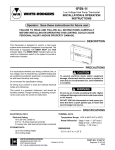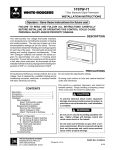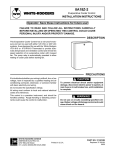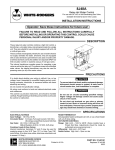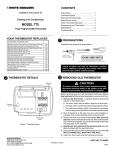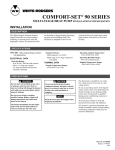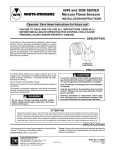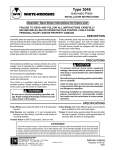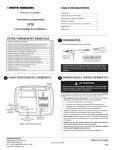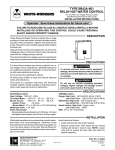Download White Rodgers 1F59-13 User's Manual
Transcript
1F59-13 WHITE-RODGERS Low Voltage Heat Pump Thermostat INSTALLATION & OPERATION INSTRUCTIONS Operator: Save these instructions for future use! FAILURE TO READ AND FOLLOW ALL INSTRUCTIONS CAREFULLY BEFORE INSTALLING OR OPERATING THIS CONTROL COULD CAUSE PERSONAL INJURY AND/OR PROPERTY DAMAGE. DESCRIPTION These thermostats are designed to control a heat pump system where automatic changeover is not required. The 1F59-13 thermostat has no indicator lights. 50 60 70 80 90 70 1F59-13 PRECAUTIONS If in doubt about whether your wiring is millivolt, line, or low voltage, have it inspected by a qualified heating and air conditioning contractor or a licensed electrician. Do not exceed the specification ratings. All wiring must conform to local and national electrical codes and ordinances. This control is a precision instrument, and should be handled carefully. Rough handling or distorting components could cause the control to malfunction. ! CAUTION To prevent electrical shock and/or equipment damage, disconnect electric power to system at main fuse or circuit breaker box until installation is complete. ! WARNING Do not use on circuits exceeding 30 volts. Higher voltage will damage control and could cause shock or fire hazard. DO NOT USE this thermostat on heat pump systems that have a spark ignition gas or fossil fuel second stage heat source. SPECIFICATIONS ELECTRICAL DATA Electrical Rating: 18 to 30 VAC, 50/60 Hz 0.01 to 1.5 amps (load per terminal) 2.5 amps max. total load (all terminals combined) STAGING DATA Up to two heating stages One cooling stage WHITE-RODGERS DIVISION EMERSON ELECTRIC CO. 9797 REAVIS ROAD ST. LOUIS, MISSOURI 63123-5398 THERMAL DATA Temperature Range: 40°F to 90°F (4°C to 32°C) Rated Differential: Stage 1 heat – 1.3°F (max.) Stage 2 heat – 0.9°F (max.) Cooling – 1.3°F (max.) DIMENSIONS 3.5” H x 5.5” w x 1.25” D PART NO. 37-5780A Printed in U.S.A. 9713 INSTALLATION SELECT THERMOSTAT LOCATION 1⁄2” hole for thermostat wire Proper location insures that the thermostat will provide a comfortable home temperature. Observe the following general rules when selecting a location: 1. Locate thermostat about 5 ft. above the floor. Stout cord with 6” chain attached 2. Install thermostat on a partitioning wall, not on an outside wall. Approximately 5 feet from floor Baseboard strip moulding 1⁄4” guide hole for sighting 3. Never expose thermostat to direct light from lamps, sun, fireplaces or any temperature radiating equipment. Quarter round removed 4. Avoid locations close to windows, adjoining outside walls, or doors that lead outside. 5. Avoid locations close to air registers or in the direct path of air from them. 3⁄4” 6. Make sure there are no pipes or duct work in that part of the wall chosen for the thermostat location. hole in floor of partition Hooked wire for snagging chain 7. Never locate thermostat in a room that is warmer or cooler than the rest of the home, such as the kitchen. 8. Avoid locations with poor air circulation, such as behind doors or in alcoves. 9. The living or dining room is normally a good location, provided there is no cooking range or refrigerator on opposite side of wall. ROUTE WIRES TO LOCATION Figure 1. Routing thermostat wires 5. Fasten thermostat base loosely to wall using two mounting screws (see fig. 2). Place a level against bottom of base, adjust until level, and then tighten mounting screws to secure base (leveling is for appearance only and will not affect thermostat operation). If holes in wall are too large and do not allow you to tighten base snugly, use plastic screw anchors to secure base. 1. If an old thermostat is being replaced and is in a satisfactory location, and the wiring appears to be in good condition, use existing wiring. If in doubt, re-wire. 3. Probe for obstructions in partition before drilling 1⁄2” hole in wall at selected location. Take up quarter round and drill a small guide hole for sighting (see fig. 1). From basement, drill 3⁄ 4” hole in partition floor next to guide hole. In houses without basements, drill 1⁄ 2” hole through ceiling and into partition from above (see fig. 1). 4. Through this hole drop a light chain, or 6” chain attached to a strong cord. Snag cord in basement with hooked wire. In houses without basements, drop cord through hole in ceiling and down partitioning; snag cord at the thermostat location. 5. Attach thermostat wire to cord and pull wire through hole in wall so that 6” of wire protrudes. ATTACH THERMOSTAT BASE TO WALL 1. Remove thermostat cover. Pull wires through opening near center of thermostat base and connect wires under terminal screws (see WIRE THERMOSTAT TO SYSTEM). 2. Push excess wire into wall and plug up hole with fire-resistant material, such as fiberglass insulation, to prevent drafts from affecting thermostat operation. 3. Place thermostat base over hole in wall for wires and mark mounting hole locations on wall. 4. Drill mounting holes. 2 2 1 Mounting Hole O F F 2. If a new location is chosen or if this is a new installation, thermostat wire must first be run to the location selected. All wiring must conform with local and national electrical codes and ordinances. Screw Anchors G O Y B Mounting Hole Figure 2. Mounting thermostat base to wall ! CAUTION Take care when securing and routing wires so they do not short to adjacent terminals or rear of thermostat. Shorted wires may result in personal injury and/or property damage. WIRE THERMOSTAT TO SYSTEM Insert stripped wires into terminal blocks, then tighten terminal screws. O F F 1 2 For best electrical connection, use solid 18 gauge wire. If you must use stranded wire, tin the wires with solder to insure a good electrical connection. 1. Strip wires back 1⁄4”. W7 2. Using needle-nose pliers, insert wire into correct terminal block opening (see figs. 3 and 4). W R 3. Tighten terminal block connector screw. L C G See System Function Table O Y B Anticipation Selection Switches 4. Repeat steps 2 and 3 for each wire. Pull wires through this opening Setpoint switch (without knob) Figure 3. Thermostat base with typical wiring ! CAUTION NOTE To prevent electrical shock and/or equipment damage, disconnect electrical power to system at main fuse or circuit breaker until installation is complete. This typical wiring diagram shows only the terminal identification and wiring hookup. Always refer to wiring instructions provided by equipment manufacturer for system hookup. All wiring should be installed in accordance with local and national codes and ordinances. Thermostat Control Circuit THERMOSTAT B O Y G W L C R SYSTEM Reversing Valve* Auxiliary Heat Relay Compressor Contactor Malfunction Switch Hot Fan Relay Reversing Valve** 120 VAC 24 VAC Neutral TRANSFORMER * Reversing valve is energized when the System Switch is in the HEAT position ** Reversing valve is energized when the System Switch is in the COOL position Figure 4. Typical wiring diagram 3. Carefully snap cover onto thermostat base. Refer to the OPERATION section for instructions on setting the thermostat for desired operation. ATTACH SETPOINT KNOB AND COVER 1. After thermostat base is mounted on wall, remove cardboard insert from setpoint switch. 2. Carefully press setpoint knob onto setpoint switch (see fig. 5). O F F 2 1 O F F 2 1 Setpoint Knob Setpoint Switch 1 G O F F 2 O Y 0 4 5 4 50 55 G 62 64 60 62 64 60 88 60 70 80 90 5 6 6 6 67 68 69 70 7 7 1 2 78 3 7 4 7 5 7 76 77 7 80 9 7 7 1 2 90 88 78 3 7 4 7 5 7 76 77 1 8 2 8 83 84 86 62 64 B 50 90 88 78 3 7 4 7 5 7 76 77 7 80 9 7 7 1 2 7 80 9 5 6 6 6 67 68 69 70 5 6 6 6 67 68 69 70 1 8 2 8 83 84 86 Y 90 0 4 5 4 50 55 Y O 0 4 5 4 50 55 60 O G A B C Figure 5. Attach setpoint knob and cover 3 1 8 2 8 83 84 86 OPERATION SWITCH POSITIONS FAN Auto SYSTEM FUNCTION SYSTEM On Cool Off Heat Emer Fan Relay Rev Valve (O) Rev Valve (B) Aux Heat Compr. Relay Contact COMPONENT OPERATION No heat - no cool - no fan - no lights Heating Mode: stage 1 calling. Fan relay, compressor contactor, and reversing valve (B) energized by thermostat. Heating Mode: both stages calling. Fan relay, compressor contactor, reversing valve (B), and auxiliary heat relay are energized. Emergency Heat Mode: aux heat, Fan Relay* and reversing valve (B) are energized. Compressor locked out. Cooling Mode: Fan relay, compressor contactor and reversing valve (O) energized. Fan On: Energizes fan relay regardless of system switch position. Indicates switch position on thermostat subbase and system function in operation. * In EMERGENCY HEAT mode, fan may be disabled if required by cutting jumper W7 (see Fig 3) This thermostat is easy to operate. The above table shows how the system will operate when the FAN and SYSTEM switches are in different positions. To set the switches, open the door on the left side of the thermostat (see fig 6). Move the FAN and SYSTEM switches up or down to select desired system operation. To set the temperature, move the temperature selection knob (on the right side of the thermostat) until the desired temperature is shown in the window. ANTICIPATION ADJUSTMENT 3. Locate the anticipation adjustment switches (see fig. 3). 6. Turn on power to the thermostat. COOL OFF HEAT EMER 50 60 70 80 90 Antic.=14* Antic.=10* (Factory setting) Antic.=16* 1 2 1 2 1 2 OFF Shorter Cycles OFF OFF Antic.=30* 1 2 OFF Longer Cycles * These numbers represent different anticipation settings. See fig. 8 for further information. 2. Remove the thermostat cover. 5. Carefully snap the cover onto the thermostat base. 70 SYSTEM Figure 6. Thermostat with door open The anticipation setting on this thermostat is adjustable. Any anticipation setting (including the factory setting) will work with any system for which this thermostat is intended for use. However, the user may be more comfortable with a particular setting. If the system is turning on and off too often (short cycles) or not often enough (long cycles) for the user’s comfort, follow these steps to adjust the anticipation. 1. Turn off power to the thermostat. 4. Using a pencil or small screwdriver, move the switches to the desired setting (see figs. 7 and 8). FAN AUTO ON Figure 7. Anticipation selection switch settings First Stage Heat and Cool Anticipation Approx. Reference Temperature Number Differential* 0.8°F 10 1.1°F 14 1.3°F 16 2.4°F 30 Second Stage and Emergency Heat Anticipation Approx. Reference Temperature Number Differential* 0.3°F 10 0.4°F 14 0.5°F 16 0.9°F 30 * These numbers are approximate and represent thermostat operation with a typical system. Actual temperature differentials may vary. Figure 8. Approximate temperature differential and cycle times LOCKOUT BYPASS OPTION FOR QUALIFIED SERVICE TECHNICIANS’ USE ONLY. OPERATORS SHOULD NOT USE THIS FEATURE DUE TO POSSIBILITY OF EQUIPMENT DAMAGE, OR PERSONAL INJURY. DO NOT USE THE LOCKOUT BYPASS OPTION UNLESS THE COMPRESSOR OIL HEATERS HAVE BEEN OPERATIONAL FOR AT LEAST 6 HOURS AND THE SYSTEM HAS NOT BEEN OPERATIONAL FOR AT LEAST 5 MINUTES. COMPRESSOR SHORT TERM CYCLE PROTECTION These thermostats have a built-in short term (5-minute) time delay. During this 5-minute period, the thermostat will lock out the compressor to allow heat pressure to stabilize. If you want to override this feature while testing thermostat operation, move the SYSTEM switch to OFF. Wait about 6 to 8 seconds, then move the SYSTEM switch back to the previous position.




